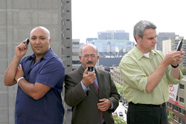Online community for handheld technology

Jason Lewis, Reza Soleymani and Michael Longford.
Photo by Andrew Dobrowolskyj
That cell phone in your pocket is about to get a lot more interesting and powerful.
The Mobile Digital Commons Network (MDCN) is one of the research projects emerging from the seed grants announced last spring by ENCS Dean Nabil Esmail and Fine Arts Dean Christopher Jackson.
This multidisciplinary undertaking has brought together an international network of artists, researchers and engineers to explore the potential of wireless communication. A joint initiative with the Banff Centre, it has just received a grant from Heritage Canada for just under $500,000.
Cell phones, personal digital assistants (PDAs), global positioning systems (GPS) and portable computers may be part of our everyday lives but we aren’t really using them to full capacity. MDCN wants to send images, text and music to mobile devices in ways never tried before.
“This is a chance to experiment in a bandwidth that is not yet heavily populated. We have some room to play and hopefully to create an online community for hand-held technology,” said Michael Longford, an associate professor in the Department of Design Art.
MDCN will also be creating a physical connection to the cyber world by making the information sensitive to location.
Jason Lewis, another associate professor in Design Art, said, “The idea is to mark up [fill] space with virtual data so that you could be on a street corner and use your wireless device to plug into data left by someone talking about an event that happened a year ago, or access the history of the building in front of you.
“It’s parallel to the Internet, but it’s a local community with a local portal that changes as the landscape and community changes.”
At the beginning, MDCN will use an existing infrastructure created by its collaborator, Île sans Fil, which for the last year has been installing hotspots throughout Montreal for free public access to wireless Internet.
“This is a chance for us to use the existing technology with more imagination,” said Reza Soleymani, Research Chair, Wireless Multimedia Communication, in the Department of Electrical & Computer Engineering.
“Of course we will need to redesign some systems, build some different transmitters and perhaps improve the software in order to see how far we can push the boundaries and still have something useful.”
This is an ambitious undertaking, so the areas of research and development have been divided into different programs. Cityspeak is a tie-in project; people will send in comments about a particular location by phone or through text messaging.
Sonic Scene is a similar proposal, but instead people will be given sound equipment to walk about recording their neighbourhood. These portraits of text and sound will be made available for downloading into your PDA.
Demos should be up and running by spring 2005.
At the same time MDCN will also be examining the social impact of wireless technology and opening up the debate on privacy and regulation.
“As the digital commons niche becomes more visible there will be a number of issues to look at,” said Michael Longford.
“What will motivate people to participate? What kind of data is being collected and what is being done with it?
“There will be lots of technical challenges and, of course, a learning curve. I’m sure we are in for some surprises.”